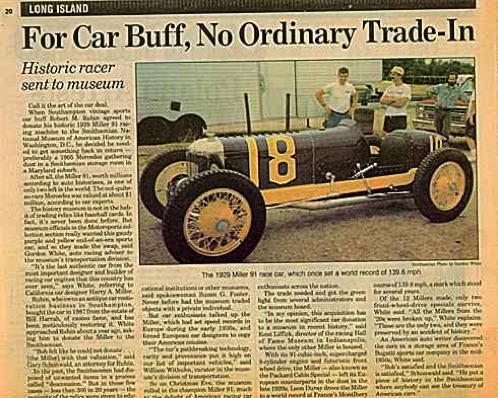about
Call it the art of the car deal.
When Southampton vintage sports car buff Robert M. Rubin agreed to donate his historic 1929 Miller 91 racing machine to the Smithsonian National Museum of American History in Washington DC, he decided he needed to get something back in return--preferably a 1905 Mercedes gathering dust in a Smithsonian storage room in a Maryland suburb.
After all, the Miller 91, worth millions according to auto historians, is one of only two left in the world. The not quite so rare Mercedes was valued at about $1 million, according to car experts.
The history museum is not in the habit of trading relics like baseball cards. In fact, it's never been done before. But museum officials in the Motorsports collection section really wanted this gaudy purple and yellow end-of-an-era sports car, and so they made the swap, said Gordon White, auto racing adviser to the museum's transportation division.
"It's the last authentic car from the most important designer and builder of racing car engines that this country has ever seen," says White, referring to California's car designer Harry A. Miller.
Rubin, who owns an antique car restoration business in Southampton, bought the car in 1987 from the estate of Bill Harrah, of casino fame, and has been meticulously restoring it. White approached Rubin about a year ago, asking him to donate the Miller to the Smithsonian.
"Bob felt like he could not donate . . . [the Miller] with that valuation," said Gary Schonwald, an attorney for Rubin.
In the past, the Smithsonian had disposed of unwanted items in a process called "deaccession." But in those few cases--less than 300 in 20 years--the majority of the relics were given to educational institutions or other museums, said spokeswoman Susan G. Foster. Never before had the museum traded objects with a private individual.
But car enthusiasts talked up the Miller, which had set speed records in Europe during the early 1930s, and forced European car designers to copy their American cousins.
"The car's pathbreaking technology, rarity and provenance put it high on our list of important vehicles," said William Withuhn, curator in the museum's division of transportation.
So on Christmas Eve, the museum rolled in the champion Miller 91, much to the delight of American racing car enthusiasts across the nation.
The trade needed and got the green light from several administrators and the museum board.
"In my opinion, this acquisition has to be the most significant car donation to a museum in recent history," said Kent Liffick, director of the racing Hall of Fame Museum in Indianapolis, where the only other Miller is housed.
With its 91-cubic inch, supercharged 8-cylinder engine and futuristic front wheel drive, the Miller--also known as the Packer Cable Special--left its European counterparts in the dust in the late 1920s. Leon Duray drove the Miller to a world record at France's Montlhery course of 139.6 mph, a mark which stood for several years.
Of the 12 Millers made, only two front-wheel-drive specials survive, White said. "All the Millers from the 20s were broken up," White explains. "These are the only two, and they were preserved by an accident of history."
An American auto writer discovered the cars in a storage area of France's Bugatti sports car company in the mid 1950s, White said.
"Bob's satisfied and the Smithsonian is satisfied," Schonwald said. "He put a piece of history in the Smithsonian where anybody can see the treasury of American cars."

Newsday
Tuesday, February 4, 1992

Press
